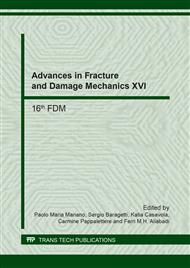p.79
p.83
p.87
p.91
p.95
p.99
p.103
p.107
p.111
Effect of Shrinkage Porosity and Degenerated Graphite on Fatigue Crack Initiation in Ductile Cast Iron
Abstract:
Heavy-section ductile iron castings solidify under low cooling rates, giving the risk to form defects like non-metallic inclusions, microporosities and degenerated shapes of graphite that have a negative effect on fatigue resistance, favoring the crack nucleation. The aim of this work is to precisely identify the defects that most affect the fatigue behavior in heavy-section castings, in order to guide the foundry to take the proper countermeasures. For this purpose, fatigue rotating bending tests were carried out on specimens machined from small-scale samples opportunely cast to reproduce long solidification times. The fracture surface of broken samples were investigated by means of Scanning Electron Microscopy in order to identify crack initiation points and fracture mechanisms. Shrinkage porosities and spiky graphite were found to play the most important effect on crack nucleation, lowering the fatigue resistance of the castings, while chunky graphite just behaved as a preferential path for crack propagation.
Info:
Periodical:
Pages:
95-98
Citation:
Online since:
September 2017
Authors:
Keywords:
Price:
Сopyright:
© 2017 Trans Tech Publications Ltd. All Rights Reserved
Share:
Citation:


